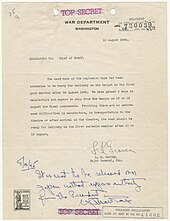
The Third Shot was the first of a series of American nuclear weapons intended for use against Japan in World War II, subsequent to the nuclear attacks on Hiroshima and Nagasaki. It was originally intended to be used on 19 August 1945, ten days after the bombing of Nagasaki. [1] It was never used, as the surrender of Japan on 15 August brought the war to a close first. [1] [2]
The Third Shot was a plutonium-239-based implosion bomb of the " Fat Man" design, similar to the bomb that was dropped on Nagasaki. [2]
Chronology

Lieutenant general Leslie Groves expected to have another "Fat Man" atomic bomb ready for use on 19 August, with three more in September and a further three in October; [3] On 10 August, he sent a memorandum to Marshall in which he wrote that "the next bomb ... should be ready for delivery on the first suitable weather after 17 or 18 August." The memo today contains hand-written comment written by Marshall: "It is not to be released over Japan without express authority from the President." [3] At the cabinet meeting that morning, Truman discussed these actions. James Forrestal paraphrased Truman as saying "there will be further dropping of the atomic bomb," while Henry A. Wallace recorded in his diary that: "Truman said he had given orders to stop atomic bombing. He said the thought of wiping out another 100,000 people was too horrific. He didn't like the idea of killing, as he said, 'all those kids.'" [4] The previous order that the target cities were to be attacked with atomic bombs "as made ready" was thus modified. [5] There was already discussion in the War Department about conserving the bombs then in production for Operation Downfall, and Marshall suggested to Stimson that the remaining cities on the target list be spared attack with atomic bombs. [6]
Two more Fat Man assemblies were readied, and scheduled to leave Kirtland Field for Tinian on 11 and 14 August, [7] and Tibbets was ordered by LeMay to return to Albuquerque, New Mexico, to collect them. [8] At Los Alamos, technicians worked 24 hours straight to cast another plutonium core. [9] Although cast, it still needed to be pressed and coated, which would take until 16 August. [10] Therefore, it could have been ready for use on 19 August. Unable to reach Marshall, Groves ordered on his own authority on 13 August that the core should not be shipped. [5]
Aftermath
After the decision was made not to use the bomb, its plutonium core was kept to be used for research. Originally nicknamed "Rufus", the core became known as the demon core following two successive lethal criticality accidents. [11] [12]
The core was melted down in summer 1946 and the material recycled for use in other cores. [13]
Notes
- ^ a b "The Third Shot". Outrider. Retrieved 2024-03-18.
- ^ a b Laboratory, Los Alamos National. "A Tale of Two Bomb Designs". Los Alamos National Laboratory. Retrieved 2024-03-18.
- ^ a b "The Atomic Bomb and the End of World War II, A Collection of Primary Sources" (PDF). National Security Archive Electronic Briefing Book No. 162. George Washington University. 13 August 1945.
- ^ Rhodes 1986, pp. 743.
- ^ a b Bernstein 1991, pp. 149–173.
- ^ Giangreco 2009, pp. 111–112.
- ^ Hoddeson et al. 1993, pp. 396–397.
- ^ Terkel, Studs (1 November 2007). "Paul Tibbets Interview". Aviation Publishing Group. Retrieved 2 January 2012.
- ^ "Lawrence Litz's Interview (2012)". Voices of the Manhattan Project. Archived from the original on 1 March 2019. Retrieved 27 February 2015.
- ^ Wellerstein, Alex (16 August 2013). "The Third Core's Revenge". nuclearsecrecy.com. Retrieved 27 January 2015.
- ^ Bernhardt, Darren (July 29, 2023). "Louis Slotin and the demon core: Winnipeg's Oppenheimer connection". CBC News. Retrieved 2024-03-18.
- ^ Milner, Richard (2021-04-10). "The Wild True Story Of World War II's Third, Unused A-Bomb". Grunge. Retrieved 2024-03-18.
- ^ Wellerstein, Alex (May 21, 2016). "The Demon Core and the Strange Death of Louis Slotin". The New Yorker. Archived from the original on May 24, 2016. Retrieved May 22, 2016.
References
- Rhodes, Richard (1986). The Making of the Atomic Bomb. New York: Simon & Schuster. ISBN 0-671-44133-7. OCLC 13793436.
- Bernstein, Barton J. (Spring 1991). "Eclipsed by Hiroshima and Nagasaki: Early Thinking about Tactical Nuclear Weapons". International Security. 15 (4): 149–173. doi: 10.2307/2539014. ISSN 0162-2889. JSTOR 2539014. S2CID 153724357.
- Giangreco, D.M. (2009). Hell to Pay: Operation Downfall and the Invasion of Japan 1945–1947. Annapolis, Maryland: Naval Institute Press. ISBN 978-1-59114-316-1. OCLC 643381863.
- Hoddeson, Lillian; Henriksen, Paul W.; Meade, Roger A.; Westfall, Catherine L. (1993). Critical Assembly: A Technical History of Los Alamos During the Oppenheimer Years, 1943–1945. New York: Cambridge University Press. ISBN 978-0-521-44132-2. OCLC 26764320.